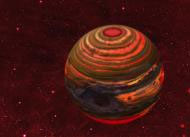Alien extreme weather, nature vs. nurture in stars and more in this week’s news
Alien extreme weather, nature vs. nurture in stars and more in this week’s news
Extreme weather on a brown dwarf
Severe weather may be common in the solar system – think Jupiter’s Great Red Spot, a raging, enormous thunderstorm on Saturn, tornadoes and hurricanes on Earth – but until recently, astronomers had spotted few storms beyond the solar system. Now, a team led by researchers at the University of Toronto describes a gigantic storm clouding the skies of the brown dwarf 2MASS J21392676+0220226, about 40 light-years away. The astronomers reported September 12 at the Extreme Solar Systems II meeting in Moran, Wyoming that the failed star’s brightness fluctuated by as much as 30 percent, which could be due to extreme variations in its atmosphere and cloud cover. —Nadia Drake
Extreme weather on a brown dwarf
Severe weather may be common in the solar system – think Jupiter’s Great Red Spot, a raging, enormous thunderstorm on Saturn, tornadoes and hurricanes on Earth – but until recently, astronomers had spotted few storms beyond the solar system. Now, a team led by researchers at the University of Toronto describes a gigantic storm clouding the skies of the brown dwarf 2MASS J21392676+0220226, about 40 light-years away. The astronomers reported September 12 at the Extreme Solar Systems II meeting in Moran, Wyoming that the failed star’s brightness fluctuated by as much as 30 percent, which could be due to extreme variations in its atmosphere and cloud cover. —Nadia Drake
 Stars’ weight is fate
Stars’ weight is fate
When it comes to stars, birth weight is almost entirely nature, not nurture, claims Mark Krumholz of the University of California, Santa Cruz. The mass a star ends up with has very little to do with the environment it’s born in. Instead, weight gain depends on things like how much heat is given off by infalling gas, which in turn affects how much gas is available for grabbing. Ultimately it’s the onset and properties of nuclear fusion inside stellar embryos’ cores that stops the gas grab and limits sizes. Surprisingly, this halt has very little to do with things like the pressure and elemental composition of the cocoon surrounding the protostar, Krumholz writes in an upcoming Astrophysical Journal. —Camille M. Carlisle
Baby galaxies with big black holes
Even little galaxies might sport some heavy-duty hardware. An international team of astronomers has determined that the glowing centers in some low-mass, “dwarf” galaxies in the distant universe are powered by supermassive black holes, previously observed churning away only at the centers of large galaxies. Using the Hubble Space Telescope, the researchers peered at galaxies from the universe’s teenage years. There, they found evidence for lurking, low-luminosity supermassive black holes in the centers of small galaxies. The finding challenges theories linking galactic evolution and supermassive black hole formation, the team reports in a paper to appear in the Astrophysical Journal. —Nadia Drake
Source:
Source: Sciencenews

 Stars’ weight is fate
Stars’ weight is fate
 Previous page
Previous page Back to top
Back to top







